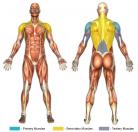Bent-Over Cross Cable Laterals
- Locate a cable machine that offers attachments on the left and right side of the body.
- Secure the single-grip attachment to both sides of the cable machine.
- Set the pulley to the lowest pin setting.
- Keeping the arms in front of the body, grab the attachment to the right of the body with the left hand.
- While still holding the attachment to the right of the body, move over and grab the attachment to the left of the body with the right hand. At this point, both hands should be crossed in front of the body.
- With a moderate bend in the knees, bend at the waist to establish a 45 degree with the back to the floor.
- Keeping a slight bend in the elbows, pull the attachments up and away from the body, inhaling throughout this motion.
- Once the hands reach head level, allow them to come back down and towards the body, exhaling throughout the motion.
- Repeat steps 7-8.
Due to the intertwined anatomy of the deltoid muscles, all three of the deltoids are used in this exercise (anterior, lateral, and posterior). The emphasis of the exercise lies on the posterior deltoid with the anterior and lateral deltoids acting as supporting structures at the peak of the lift.
The upper back is also in use at the peak of the lift. As the arms reach their maximum lifting point, the shoulder blades are squeezed together allowing the trapezius muscles to contract. As the weight is lowered, the rhomboids will be used to control the weight back down.
Be sure to keep the hands from going above head level at the peak of this exercise. Extending beyond this point can lead to injury. The muscles of the rotator cuff are particularly susceptible due to the isolating nature of bent-over cross cable laterals.





